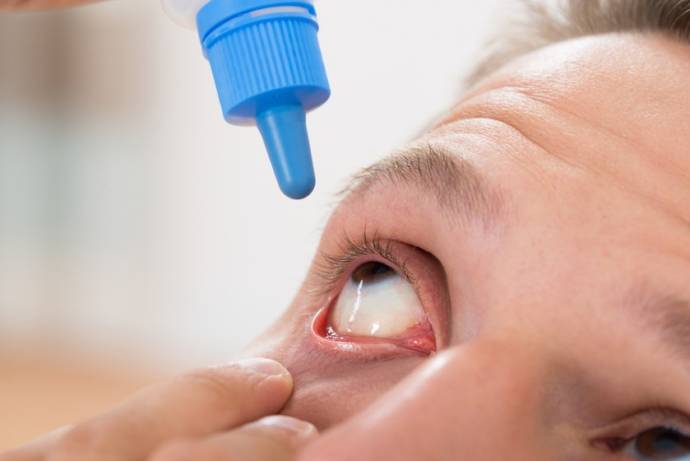It is an eye disease due to which the optic nerve gets completely damaged. The optic nerve is the image carrier to the retina. It a specialized light sensing tissue connected to the brain which helps us to see things. The fragile nerve fibers of the optic nerve are damaged by the excess pressure on eyes.
The increased eye pressure is known as intraocular pressure. When a certain amount of nerve fibers are damaged blind spots develops in the field of vision. The continuous damage to the optic nerve from high eye pressure can lead to loss of vision permanently. Without treatment, glaucoma can cause permanent blindness within a few years.
For a person of age over 40 and have a family history of glaucoma should go through a complete eye exam every one or two years. Early detection and treatment by an ophthalmologist are the keys to preventing glaucoma.
Glaucoma usually occurs when eye pressure increases. This can happen when eye fluid, called aqueous humor, is not circulating normally in the front portion of the eye. Basically it flows out of the eye through a lattice (a kind of channel). Due to the blockage in this channel the fluid stores up and leads to glaucoma.
The doctors don’t know the exact cause of the blockage, but knows that it can be inherited, that is it’s passed from the parents to the children. The other reasons leading to glaucoma are severe eye infection, inflammatory conditions of the eye, any sort of chemical injury to the eye, blood vessel clogging in the eye and at times eye surgery for various other eye conditions. It commonly appears in both eyes but differ in the level of affecting the optic nerve.
Types of glaucoma
Open-angle glaucoma
Persistent open-angle glaucoma is the most widespread form of glaucoma. The open drainage angle of the eye can get blocked leading to gradual increased eye pressure, or intraocular pressure. If this increased pressure leads to optic nerve damage, then it is known as chronic open-angle glaucoma. The optic nerve damage occurs so gradually and painlessly that the person is not aware of the badly damaged optic nerve.
Angle-closure glaucoma
Due to the complete blockage of the drainage angle, the angle closure glaucoma is caused. The iris may lead to the blockage of the drainage angle which can cause severe pressure on the optic nerve. When drainage angle of the eye gets completely blocked suddenly, pressure increases rapidly and is called angle-closure glaucoma.
The symptoms for this type of glaucoma include severe eye pain, nausea and vomiting, blurred vision and headache, rainbow around light. This form of glaucoma can evolve to permanent blindness if not treated by the ophthalmologist in the initial stages.
The evolution of angle closure glaucoma is known as chronic angle closure glaucoma, here the drainage angle of the eye gets blocked gradually and stops the flow of the eye fluid. This form of glaucoma is very common among the people of African and Asian ancestry, and in certain eye conditions.
Exfoliation syndrome
Another common form of open angle glaucoma is the exfoliation syndrome. This occurs when there is an upsurge of whitish, abnormal material on the drainage angle and lens of the eye. The pigment from the back of the iris and this whitish material can clog that drainage system of the eye, causing rapid eye pressure. This form of glaucoma can be treated well using laser treatment.
Pigmentary glaucoma
This kind glaucoma is a condition which commonly affects young, nearsighted, Caucasian males. In this condition, the iris comes in contact with the support structures that hold the lens in place due to bending in backward direction.
The cells lining the back surface of the iris containing pigment is disrupted by this position and as a result the drainage system of the eye is filled with pigment particles. Resulting to an increase in eye pressure this pigment clogs the drainage system. This form of glaucoma can be treated using laser treatment.
Other types of glaucoma may also be caused by tumors, injuries to the eye and other eye diseases. In some cases children are also affected by a rare type of glaucoma at birth.
Symptoms
In maximum cases there is hardly any or no symptom of glaucoma. The 1st symptom of glaucoma is mainly loss of peripheral vision, which can go overlooked until any further complications with your vision.
It is considered as the vision creep thief due to no sign of any symptoms at the initial stages. Depending on this, a person should go through a complete eye examination in every 2 years for detecting glaucoma at an early stage.
Though, we have gathered some information on the symptoms of glaucoma below so that you can detect it before it’s too late:
- Abnormal difficulties while adjusting to dark rooms.
- Intricacy when focusing on distant or objects closer to your eyes.
- The iris changing its color.
- Watery eyes or surfeit tearing.
- Encrusted, red-dimmed or swollen lids.
- A frequent pain in or around your eyes.
- Dual vision.
- Dark spot at the centre of the vision.
- Lines and edges appear wavy and distorted.
- Dry eyes with burning or itching sensation.
- Unexpected loss of vision in any one of your eyes.
- Blurred vision.
- Due to any unusual sensitivity to light or glare, squinting or blinking.
- Rainbows or halos around light.
- Seeing ghost like images which are basically black spots.
The symptoms listed above may not always mean that one has glaucoma but if more than one symptom is seen then one should see an eye doctor.
Treatment Options for Glaucoma
– Eye drops
– Laser therapy
– Surgery
– Medications
– Dietary changes
– Acupuncture
– Yoga
– Massage therapy
– Herbal remedies
– Cognitive behavioral therapy
Medicines
To treat glaucoma with the help of medicines, you can either opt for eye drops or pills depending on the condition of the glaucoma. These medications will lower the eye pressure and alter the circulation of eye fluid, either by escalating the flow parting the drainage angle or by declining the production of fluid within the eye and also if one experiences any of the side effects he/she should let the ophthalmologist immediately know that. It is important to let all the doctors of the glaucoma medications being taken as they have side effects. Some side effects from the eye drops includes red eyes, headaches, changes in pulse, a stinging sensation, heavy breathing, blurred vision and rise in heartbeat. Other side-effects due to pills that may arise are drowsiness, bowel irregularities, tingling of fingers and toes, kidney stones, loss of appetite, anemia and bleeding disorders.
Laser surgery
It is one of the effective and prescribed treatments for glaucoma. For treating open angle glaucoma, Trabeculoplasty is the laser treatment to boost the eye drainage function and to control the eye pressure. Another treatment to cure glaucoma is Iridotomy, according to which tiny holes are created in the iris to advance the flow of eye fluid through the drains when taking care of narrow angle glaucoma.
Operative surgery
In case of operative surgery, the ophthalmologist will use some specialized instruments to create a bypass drainage lattice for the eye fluid to flow, along with a microscope for treating glaucoma. This new passage will release the blocked fluid and diminish the pressure on your eyes. Surgery will be recommended by the ophthalmologist only when he feels that the benefit of a lower eye pressure can be achieved with an operation prevails over possible complications or further string of optic nerve damage.
How to prevent it?
The open angle primary glaucoma cannot be prevented, but the loss of vision and the optic nerve damage can be prevented by taking preventive measures at the preliminary stages. Effective treatment at an early stage can help you get rid of it easily.
On the other hand, the secondary type of glaucoma can be cured by avoiding severe trauma to the eye and prompt treatment of irritation or eye inflammation and other eye conditions leading to secondary type of glaucoma. With the help of iridotomy, most primary type of glaucoma is cured but at the risk of developing chronic angle closure glaucoma later on.





